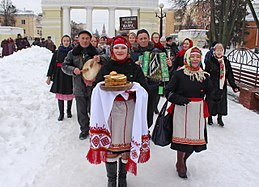The Mari People: The Last Pagans Of Europe
 |
| Mari people in Yoshkar-Ola |
Early History |
A few researchers have suggested that two clans referenced by the
Gothic essayist Jordanes in his Getica among the people groups in the domain of
Gothic ruler Ermanaric in the fourth century CE can be likened to the Mari
public. Notwithstanding, the ID of the Imniscaris (or Sremniscans) with
"Cheremis", and Merens with "Mari" is dubious. The main
securely confirmed notice of the Mari public comes from Khazar sources from the
tenth 100 years, where they show up by the exonym tsarmis (=
"Cheremis"). Around then, the Mari settlement region was along the
Volga. In the thirteenth hundred years, the Mari fell impaired circle of the
Brilliant Swarm, and in 1443 became subjects of the Kazan khanate. During this
time, the Maris encountered some social combination with the decision Tatars
and the Volga Bulgars, which is likewise found in Turkic lexical and linguistic
effects on the Mari language.
In 1552, the Mari domain was integrated into Russia with the
Russian success of Kazan under Ivan the Horrendous. While certain Maris
(generally Slope Maris) helped the Russian victory, most of the Maris retaliated
in the supposed "Cheremis Wars". Toward the finish of the sixteenth
hundred years, obstruction was at last subdued, leaving a weighty cost for the
Mari populace. Because of the resulting flood of Russian pioneers, and to get
away from constrained Christianization (beginning from c. 1700), Maris began to
settle further east in present-day Bashkortostan. In the next hundreds of years
under tsarist Russia, the Maris had the option to hold their ethnic and social
character, supported by rehashed rushes of getting back to their conventional
pre-Christian religion.
Soviet Union
During the Soviet Time, the Mari Area was set up under the support of Narkomnats, the People groups Commissariat for ethnicities. Its assignment was to work with the nearby association of the Mari nation with others, to nullify hostility to the Russian questions and to raise the "class awareness" of Mari laborers. By and by this included working with grain orders by the Soviet express, the enrollment of troopers for the Red Armed force, and the execution of Trotskyite control of the general public.
During the Soviet Time, huge quantities of ethnic Russians were moved into generally Mari lands, essentially changing the socioeconomics of the locale, and making the Mari a minority in many pieces of their country. Mari individuals were by and large debilitated by these changes. Moreover, Trotskyite strategies formally pointed toward fighting the unnecessary impact of patriotism in a multi-country association, brought about the homicide of driving Mari figures, like Sergei Čavajn and Olyk Ipai and different educators, researchers, specialists, as well as strict and local area pioneers.
Russian League
Following
the breakdown of the Soviet Association, the recently made republic of Mari El
saw a restoration of Mari culture and language. Notwithstanding, following the
arrangement of Leonid Markelov as the Top of the republic in 2001, the public
authority of Mari El has sought a strategy of extreme Russification in the
locale. As per Vasily Pekteyev of the Mari Public Auditorium in Yoshkar-Ola,
"[Markelov] abhorred the Mari public". He noticed that the Mari
language is not generally shown in towns or schools and that the republic of
Mari El "has previously quit being an ethnic republic in everything except
name. We are simply one more oblast." In 2005, the European Commission
communicated its anxiety over reports of suppression against ethnic Mari
resistance figures, columnists, and government authorities that advanced Mari
culture and went against Markelov's reappointment as top of the republic that
year.
 |
| Mari pagan priests (kart) |
Ethnic groups |
The Mari public comprises four distinct gatherings: the Knoll Mari, who live
along the left bank of the Volga, the Slope (Mountain) Mari, who live along the
right bank of the Volga, the Northwestern Mari, who live in the Southern piece of
Kirov Oblast and Eastern piece of Nizhny Novgorod Oblast, and Eastern Mari, who
lives in the Bashkortostan, Tatarstan, Udmurtia republics and Perm Krai and
Sverdlovsk Oblast. In the 2002 Russian enumeration, 604,298 individuals
recognized themselves as "Mari," with 18,515 of those determining
that they were Mountain Mari and 56,119 as Eastern Mari. Practically 60% of
Mari lived in rustic regions.
Mari Language |
The Mari have their own language, likewise
called Mari, which is an individual from the Uralic language family. It is
composed of a changed form of the Cyrillic letter set. Language specialists
today recognize four distinct tongues, which are not all understandable
together: Slope Mari (мары йӹлмӹ), thought chiefly along the right Volga bank;
Knoll Mari (марий йылме), verbally expressed in the swamp locales of the
Kokshaga and Volga streams, which incorporates the city of Yoshkar-Ola; Eastern
Mari, expressed east of the Vyatka Waterway; and Northwestern Mari (маре йӹлмӹ)
in the South-West of Kirov Oblast and North-East of Nizhny Novgorod Oblast. In
the 2002 registration, 451,033 individuals expressed that they communicated in
the Mari language.
 |
| Yvan Kyrlya, a Mari Soviet actor and poet. |
Mari Religion |
Maris has generally polished shamanistic confidence that firmly associated the person with nature. As per those convictions, nature applies an impact on individuals. Nature is viewed as a hallowed, strong, and living being with which individuals are completely entwined. Nature likewise fills in as a wellspring of outright great who generally helps people as long as they shun hurting or restricting it.
The Mari local religion
likewise has a pantheon of divine beings who live in the sky, the most
significant of whom is known as the Incomparable White God (Ош Кугу Юмо, Osh
Kugu Yumo). Other lesser divine beings incorporate the lord of fire (Тул Юмо, Tul
Yumo) and the lord of wind (Мардеж Юмо, Mardezh Yumo). The Mari likewise have
confidence in various half-men, half-divine beings (керемет, keremet) who live
on the planet. The most worshipped of these is Chumbulat (Чумбулат), or
Chumbylat (Чумбылат), a prestigious pioneer and champion.
Endeavors to switch the
Maris over completely to Christianity started in the sixteenth hundred years
after their domain was integrated into the Russian Realm during the rule of
Ivan IV "the Awful". Strain to switch over completely to Christianity
and embrace Russian culture by the tsarist experts in the seventeenth and
eighteenth centuries prompted a reaction by the Maris as they confronted
mistreatment to conform. Reception of Christianity was not general, in any
case, and numerous Mari today actually practice agnosticism in syncretic
structures, or cleaner structures sticking to coordinated neopagan Mari
customary religion organizations. While most Mari today are individuals from the Russian Standard Church,
agnostics actually contain a huge minority of 25 to 40% of the populace.
 |
| The Mari People's Religion |
Faith of Mari People |
Paganism in europe |
Paganism, also known as pre-Christian belief systems, has a long and varied history in Europe. In the ancient world, various forms of paganism were practiced throughout the continent, including the worship of Greek and Roman gods, Celtic polytheism, and Germanic mythology. Despite the widespread adoption of Christianity throughout Europe, many of these pre-Christian beliefs and practices have survived to the present day, influencing modern paganism in Europe.
One
of the most well-known forms of paganism in Europe is Celtic polytheism, which
was practiced by the ancient Celts. This belief system was centered around the
worship of a variety of gods and goddesses, who were believed to be responsible
for various aspects of life, such as fertility, war, and agriculture. The Celts
also believed in reincarnation and the power of nature, and many of their
rituals and ceremonies were focused on these beliefs.
Germanic
mythology, another form of paganism practiced in Europe, is closely related to
Norse mythology and the belief in the gods of Asgard, such as Odin, Thor, and
Loki. This belief system was practiced by the ancient Germans, as well as other
Scandinavian and Northern European cultures. Like the Celts, the ancient
Germans believed in the power of nature and the importance of rituals and
sacrifices to appease the gods.
In
addition to these well-known belief systems, there were also many other forms
of paganism practiced throughout Europe, including the worship of Greek and
Roman gods and goddesses. The ancient Greeks and Romans believed in a pantheon
of deities who were responsible for various aspects of life, such as love,
wisdom, and war. These beliefs were later incorporated into the practice of
Christianity, with many of the pagan gods and goddesses being assimilated into
the Christian pantheon as saints. Despite the widespread adoption of
Christianity throughout Europe, many of these pre-Christian belief systems have
managed to survive to the present day. Today, there are many people in Europe
who practice modern forms of paganism, which often incorporate elements of
ancient belief systems with more contemporary spiritual practices. These modern
pagans may celebrate ancient festivals, such as the winter solstice or the
summer solstice, and may also engage in rituals and ceremonies that are
inspired by the beliefs of their ancestors. Overall, paganism has a rich and
varied history in Europe, with a number of different belief systems that have
influenced modern spiritual practices. From the worship of Greek and Roman gods
to the belief in the power of nature, paganism has played a significant role in
shaping the spiritual landscape of Europe.
Last pagans in scandinavia |
The last pagans in Scandinavia were members of a pre-Christian belief system that was practiced in the region until the late Middle Ages. This belief system was centered around the worship of a pantheon of gods and goddesses, who were believed to be responsible for various aspects of life, such as fertility, war, and agriculture. The Vikings, who were a group of seafaring warriors from Scandinavia, were particularly known for their devotion to these deities.
Despite
the widespread adoption of Christianity throughout Scandinavia, many of these
pre-Christian beliefs and practices survived well into the Middle Ages. In
fact, it was not until the 13th and 14th centuries that the last of the pagan
beliefs in Scandinavia were finally suppressed. There are several reasons why
paganism was able to survive for so long in Scandinavia. One of the main
reasons was the strong oral tradition that was prevalent in the region. The
Vikings were known for their love of storytelling and poetry, and many of the
myths and legends of their gods and goddesses were passed down through the
generations through oral tradition. This helped to keep the ancient beliefs
alive, even as Christianity began to spread throughout the region.
Another
reason for the survival of paganism in Scandinavia was the strong sense of
community that existed in the region. The Vikings were fiercely independent
people, and their beliefs were deeply rooted in their sense of identity as a
community. This made it difficult for Christianity to fully take hold, as many
people resisted the idea of abandoning their traditional beliefs in favor of a
new religion. Despite the efforts of Christian missionaries to convert the last
pagans in Scandinavia, many of their beliefs and practices survived well into
the Middle Ages. Today, there are many people in Scandinavia who are interested
in reviving some of these ancient beliefs, and there are many modern pagan
groups that draw inspiration from the traditions of their ancestors.
Overall,
the last pagans in Scandinavia were a fascinating group of people who held fast
to their ancient beliefs and traditions, even as the world around them changed.
Their legacy can still be seen in the modern-day fascination with Norse
mythology and the enduring popularity of Viking culture.
Genetics of Mari People |
Osteopetrosis influences 1 infant out of each 20,000 to 250,000 around the world, however, the chances are a lot higher in the Russian district of Mari El with 1 of each and every 14,000 babies impacted.












Post a Comment
0 Comments
Please do not entery any spam link in the comment box!